
The Cyperaceae are a family of graminoid (grass-like), monocotyledonous flowering plants known as sedges. The family is large, with some 5,500 known species described in about 90 genera, the largest being the "true sedges" genus Carex with over 2,000 species.

Trema is a genus of about 15 species of evergreen trees closely related to the hackberries (Celtis), occurring in subtropical and tropical regions of southern Asia, northern Australasia, Africa, South and Central America, and parts of North America. They are generally small trees, reaching 10–20 m (33–66 ft) tall.

Byrsonima crassifolia is a species of flowering plant in the family Malpighiaceae, native to tropical America. Common names used in English include nance, maricao cimun, craboo, and golden spoon. In Jamaica it is called hogberry.

Columnea is a genus of ca. 200 species of epiphytic herbs and shrubs in the flowering plant family Gesneriaceae, native to tropical America and the Caribbean. The tubular or oddly shaped flowers are usually large and brightly colored – usually red, yellow, or orange – sometimes resembling a fish in shape. A common name is flying goldfish plants due to the unusual flower shape.

Ulmus crassifoliaNutt., the Texas cedar elm or simply cedar elm, is a deciduous tree native to south central North America, mainly in southern and eastern Texas, southern Oklahoma, Arkansas and Louisiana, with small populations in western Mississippi, southwest Tennessee and north central Florida; it also occurs in northeastern Mexico. It is the most common elm tree in Texas. The tree typically grows well in flat valley bottom areas referred to as 'Cedar Elm Flats'. The common name 'cedar elm' is derived from the trees' association with juniper trees, locally known as cedars.

Tristaniopsis is a group of shrub and tree in the myrtle family Myrtaceae described as a genus in 1863. They have a wide distribution in Southeast Asia, New Guinea, New Caledonia and Australia.

Araucaria luxurians is a species of conifer in the family Araucariaceae. It is known by the common names Sapin de Noël and Coast araucaria. It is endemic to New Caledonia, where it grows in several small subpopulations. It grows in ultramafic soils in humid forests and on cliffs and slopes. It is threatened by habitat loss and none of the subpopulations are in protected areas.

Araucaria muelleri is a species of conifer in the family Araucariaceae. It is a medium size tree, 10–25 meters in height, with larger leaves than most other New Caledonian Araucarias. It is found only in New Caledonia, in several sites in the far south of Grande Terre, the main island.

Beauprea is a genus of flowering plants in the family Proteaceae. Its 13 extant species are endemic to New Caledonia, though closely related forms have been found in the fossil records of Australia and New Zealand. Its closest extant relatives are the African Protea and Faurea.
Cyphokentia macrostachya is a species of palm endemic to New Caledonia.
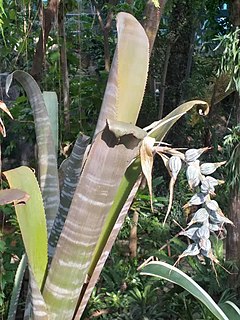
Billbergia vittata is a plant species in the genus Billbergia. This species is native to Brazil.
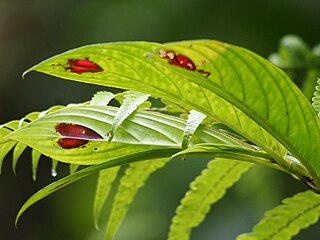
Columnea consanguinea is a species of flowering plants in the genus Columnea. They are endemic to Colombia, Costa Rica, Ecuador, Nicaragua, and Panama. They are distinctive for possessing red translucent heart-shaped markings on their leaves that serve to attract their main pollinators - the hummingbird Heliodoxa jacula - to their more inconspicuous flowers.
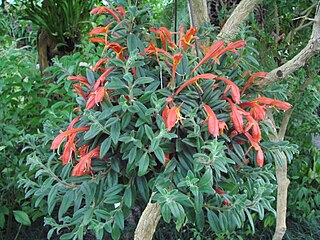
Columnea hirta is a species of flowering plants in the genus Columnea. They are endemic to Costa Rica and Panama but are widely cultivated as an ornamental.

Hakea pandanicarpa is a shrub species in the family Proteaceae. It is endemic to south-west Western Australia.
Sleumerodendron is a monotypic genus of plant in the family Proteaceae. The sole species is Sleumerodendron austrocaledonicum.
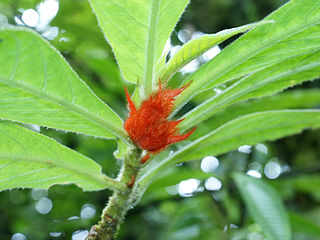
Columnea purpurata is a species of Gesneriaceae that is native to Costa Rica, Colombia, and Belize.

The Gesnerioideae are a subfamily of plants in the family Gesneriaceae: based on the type genus Gesneria. Although genera typically originate in the New World, some species have become widely distributed as ornamental plants.
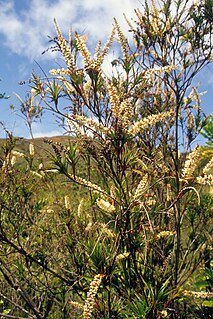
Dracophyllum ramosum is a species of shrub or small tree in the family Ericaceae and is endemic to New Caledonia. It was first described by Adolphe-Théodore Brongniart and Jean Antoine Arthur Gris in 1864 and gets the specific epithet ramosum for the fact that many of its branches grow from the same place. It inhabits the summits and slopes of mountains, alongside streams, and on plateaux; it reaches a height of 0.5–5 m.
Pomaderris crassifolia is a species of flowering plant in the family Rhamnaceae and is endemic to eastern Australia. It is a shrub with hairy young stems, egg-shaped or elliptic leaves, and clusters of cream-coloured or yellow flowers.
Cyperus appendiculatus is a species of sedge that is native to parts of Brazil.
















